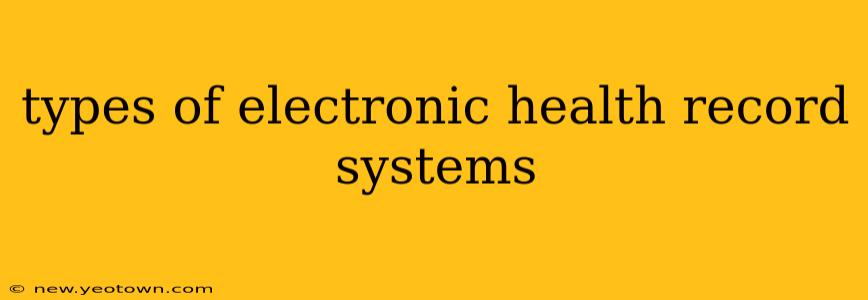Navigating the World of Electronic Health Record (EHR) Systems: A Comprehensive Guide
The world of healthcare is undergoing a digital revolution, and at the heart of this transformation lies the Electronic Health Record (EHR). But EHRs aren't a one-size-fits-all solution. Different healthcare settings and practices have diverse needs, leading to a variety of EHR system types. Let's unravel the intricacies of these systems, exploring their unique features and functionalities.
Imagine a bustling hospital, a small family practice, and a sprawling network of clinics – each requires a different approach to managing patient data. This is where the diverse landscape of EHR systems comes into play. This isn't just about storing patient records; it's about optimizing workflows, improving patient care, and ensuring compliance with regulations. Let's dive into the different types:
1. What are the different types of EHR systems available?
This is a fundamental question, and the answer is multifaceted. EHR systems aren't just categorized by their features but also by their target users and the scope of their functionality. Broadly, we can classify them into:
-
Cloud-based EHRs: These systems store data on remote servers, accessible via the internet. This offers scalability, accessibility, and often lower upfront costs. Think of it like accessing your emails – you don't need to own the server, just a device with internet access. This is becoming increasingly popular due to its flexibility and cost-effectiveness.
-
On-premise EHRs: This traditional approach involves installing and maintaining the software on the healthcare provider's own servers. While this gives more control over data security and customization, it requires significant investment in hardware, software, and IT personnel for maintenance and updates.
-
Hybrid EHRs: A blend of the two above, combining the benefits of both cloud and on-premise systems. Critical data might reside on-site for security reasons, while less sensitive information is stored in the cloud for accessibility. This offers a balance between control and flexibility.
-
Specialty-Specific EHRs: These systems are designed to meet the unique needs of specific medical specialties, like dentistry, ophthalmology, or cardiology. They often include features and functionalities tailored to the specific workflows and data requirements of that specialty. For example, a dental EHR might have modules for charting tooth conditions and treatment plans, functionalities not typically found in a general-purpose EHR.
2. What are the key features to look for in an EHR system?
Choosing the right EHR is crucial. Several key features should be on your checklist:
-
Interoperability: The ability to seamlessly exchange data with other healthcare systems is critical for efficient care coordination. This ensures that different providers can access a patient's complete medical history, regardless of where they received care.
-
User-friendliness: A well-designed EHR should be intuitive and easy to use, minimizing training time and frustration for staff. Clunky interfaces can significantly impact workflow efficiency.
-
Security: Patient data is highly sensitive, requiring robust security measures to protect it from unauthorized access and breaches. Compliance with HIPAA regulations is paramount.
-
Reporting and analytics: EHRs should offer robust reporting capabilities to track key performance indicators, monitor patient outcomes, and identify areas for improvement.
3. How do different types of EHR systems compare in terms of cost and functionality?
The cost of an EHR system can vary significantly depending on the type, features, and vendor. Cloud-based systems typically have lower upfront costs but may involve ongoing subscription fees. On-premise systems require a larger initial investment in hardware and software but may have lower long-term costs. Functionality also differs: specialty-specific EHRs offer tailored features, potentially at a higher price point, while general-purpose EHRs provide broader functionality but may lack the depth of specialty-specific solutions.
4. What are the benefits and drawbacks of using different types of EHR systems?
Choosing the right EHR system is a strategic decision that needs careful evaluation. Cloud-based systems offer accessibility, scalability, and cost-effectiveness, but might raise concerns about data security and vendor lock-in. On-premise systems offer greater control and customization but demand a higher initial investment and ongoing IT support. The best choice depends on the specific needs and resources of the healthcare organization.
This journey into the world of EHR systems demonstrates their crucial role in modern healthcare. Understanding the different types, features, and considerations involved in selecting an EHR is essential for healthcare providers to effectively manage patient data, improve care, and navigate the complexities of the digital healthcare landscape. The future of healthcare is undeniably intertwined with the evolution and sophistication of these systems.

